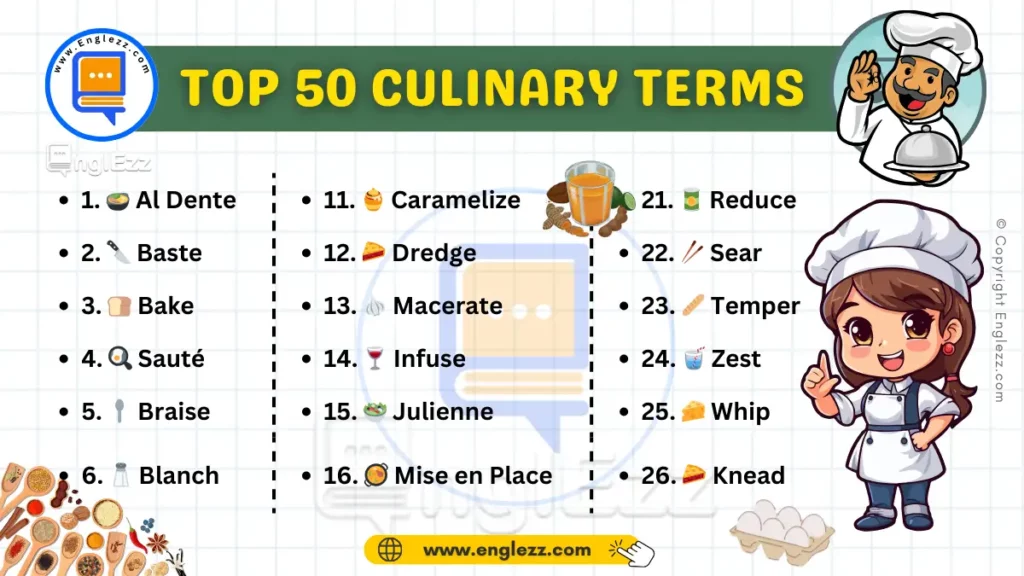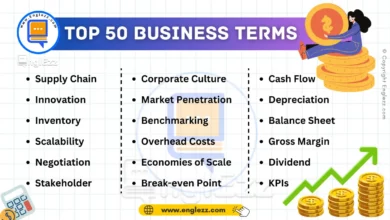If you’re passionate about cooking or find yourself lost in the language of professional kitchens, mastering culinary terminology is key to understanding recipes and techniques. Whether you’re a home cook or an aspiring chef, knowing these terms can elevate your cooking game. This guide covers 50 of the most common culinary English terms, each with a definition, phonetic transcription, and examples of how they are used.
Table of Contents
- 50 Most Common Culinary English Terms Explained with Examples
- #1. 🍲 Al Dente (al-DEN-tay)
- #2. 🔪 Baste (beyst)
- #3. 🍞 Bake (beyk)
- #4. 🍳 Sauté (soh-TEY)
- #5. 🥄 Braise (breyz)
- #6. 🧂 Blanch (blanch)
- #7. 🧀 Chiffonade (shif-uh-NAHD)
- #8. 🥣 Deglaze (dee-GLEYZ)
- #9. 🧈 Clarify (KLAR-uh-fahy)
- #10. 🥖 Crimp (krimp)
- #11. 🍯 Caramelize (KAR-uh-muh-lahyz)
- #12. 🥧 Dredge (drej)
- #13. 🧄 Macerate (MAS-uh-rayt)
- #14. 🍷 Infuse (in-FYOOZ)
- #15. 🥗 Julienne (joo-lee-EN)
- #16. 🥘 Mise en Place (meez ahn PLAHS)
- #17. 🥩 Marinate (MAR-uh-nayt)
- #18. 🥚 Poach (pohch)
- #19. 🥄 Purée (pyoo-REY)
- #20. 🧄 Render (REN-der)
- #21. 🥫 Reduce (ri-DOOS)
- #22. 🥢 Sear (seer)
- #23. 🥖 Temper (TEM-per)
- #24. 🥤 Zest (zest)
- #25. 🧀 Whip (wip)
- #26. 🥧 Knead (need)
- #27. 🥄 Whisk (wisk)
- #28. 🥣 Fold (fohld)
- #29. 🥕 Grate (greyt)
- #30. 🧂 Emulsify (ih-MUHL-suh-fy)
- #31. 🍳 Simmer (SIM-er)
- #32. 🥥 Blend (blend)
- #33. 🥛 Brine (brin)
- #34. 🧂 Season (SEE-zuhn)
- #35. 🥄 Dice (dahys)
- #36. 🥖 Proof (proof)
- #37. 🍲 Steep (steep)
- #38. 🥛 Scald (skawld)
- #39. 🥔 Mash (mash)
- #40. 🍋 Degrease (dee-GREES)
- #41. 🥘 Broil (broyl)
- #42. 🥒 Core (kohr)
- #43. 🧈 Sift (sift)
- #44. 🥣 Steam (steem)
- #45. 🥛 Scallop (SKOL-up)
- #46. 🍖 Carve (kahrv)
- #47. 🥖 Glaze (gleyz)
- #48. 🥦 Parboil (PAHR-boil)
- #49. 🧄 Mince (mins)
- #50. 🍋 Drizzle (DRIZ-uhl)
- Culinary English Terms Table
- Conclusion
50 Most Common Culinary English Terms Explained with Examples
From basic terms like “bake” and “sauté” to more advanced concepts like “mise en place” and “chiffonade,” this list will help you speak the language of the kitchen fluently. Let’s dive into the world of culinary vocabulary! #EnglEzz #vocabulary #culinaryterms
#1. 🍲 Al Dente (al-DEN-tay)
Definition: Cooked so as to be still firm when bitten.
Examples:
- “Cook the pasta al dente for the perfect texture.”
- “Vegetables should be al dente, not mushy.”
#2. 🔪 Baste (beyst)
Definition: To pour juices or melted fat over meat during cooking to keep it moist.
Examples:
- “Remember to baste the turkey every 30 minutes.”
- “Basting the roast enhances its flavor.”
#3. 🍞 Bake (beyk)
Definition: To cook by dry heat, usually in an oven.
Examples:
- “Bake the cookies at 350°F for 12 minutes.”
- “She loves to bake fresh bread every weekend.”
#4. 🍳 Sauté (soh-TEY)
Definition: To fry quickly in a small amount of fat.
Examples:
- “Sauté the onions until they’re translucent.”
- “Sauté the garlic for a burst of flavor.”
#5. 🥄 Braise (breyz)
Definition: To cook meat slowly in a closed container with a small amount of liquid.
Examples:
- “Braise the beef in red wine for tender results.”
- “She braised the vegetables for added depth.”
#6. 🧂 Blanch (blanch)
Definition: To scald food briefly in boiling water, then plunge into cold water to stop cooking.
Examples:
- “Blanch the tomatoes to remove their skins.”
- “Blanch the broccoli before stir-frying.”
#7. 🧀 Chiffonade (shif-uh-NAHD)
Definition: To finely slice or shred leafy vegetables or herbs. Examples:
- “Chiffonade the basil for the garnish.”
- “A chiffonade of lettuce adds elegance to the dish.”
#8. 🥣 Deglaze (dee-GLEYZ)
Definition: To loosen the flavorful bits from the bottom of a pan by adding liquid.
Examples:
- “Deglaze the pan with white wine.”
- “Use broth to deglaze and create a sauce.”
#9. 🧈 Clarify (KLAR-uh-fahy)
Definition: To make a liquid clear by removing solid impurities.
Examples:
- “Clarify the butter before using it in the sauce.”
- “Clarified butter is essential for this recipe.”
#10. 🥖 Crimp (krimp)
Definition: To pinch or press together the edges of pastry.
Examples:
- “Crimp the edges of the pie to seal it.”
- “She crimped the dough with a fork for a decorative finish.”

#11. 🍯 Caramelize (KAR-uh-muh-lahyz)
Definition: To cook sugar until it turns brown and forms caramel.
Examples:
- “Caramelize the onions for a sweet flavor.”
- “She caramelized the sugar for the dessert.”
#12. 🥧 Dredge (drej)
Definition: To coat food with flour or breadcrumbs before frying.
Examples:
- “Dredge the chicken in flour before frying.”
- “She dredged the fish in breadcrumbs for a crispy coating.”
#13. 🧄 Macerate (MAS-uh-rayt)
Definition: To soak food in liquid to soften it or infuse it with flavor.
Examples:
- “Macerate the strawberries in sugar.”
- “The chef macerated the fruit in liqueur.”
#14. 🍷 Infuse (in-FYOOZ)
Definition: To steep an ingredient in liquid to extract its flavor.
Examples:
- “Infuse the tea with fresh herbs.”
- “She infused the oil with garlic.”
#15. 🥗 Julienne (joo-lee-EN)
Definition: To cut vegetables into thin, matchstick-like strips.
Examples:
- “Julienne the carrots for the salad.”
- “The chef julienned the bell peppers.”
#16. 🥘 Mise en Place (meez ahn PLAHS)
Definition: The preparation of ingredients before cooking.
Examples:
- “Practice mise en place for a smoother cooking process.”
- “The kitchen staff completed the mise en place before service.”
#17. 🥩 Marinate (MAR-uh-nayt)
Definition: To soak food in a flavored liquid before cooking.
Examples:
- “Marinate the chicken overnight for best results.”
- “She marinated the beef in a soy sauce mixture.”
#18. 🥚 Poach (pohch)
Definition: To cook gently in simmering liquid.
Examples:
- “Poach the eggs for a delicate texture.”
- “She poached the salmon in a broth.”
#19. 🥄 Purée (pyoo-REY)
Definition: To blend food until it becomes smooth.
Examples:
- “Purée the soup until it’s creamy.”
- “She puréed the vegetables for the sauce.”
#20. 🧄 Render (REN-der)
Definition: To melt down fat.
Examples:
- “Render the bacon fat for cooking.”
- “She rendered the lard for the pie crust.”
#21. 🥫 Reduce (ri-DOOS)
Definition: To thicken and intensify the flavor of a liquid by boiling it.
Examples:
- “Reduce the sauce by half.”
- “She reduced the stock to a rich consistency.”
#22. 🥢 Sear (seer)
Definition: To brown the surface of food quickly with high heat.
Examples:
- “Sear the steak on both sides.”
- “She seared the tuna for a perfect crust.”
#23. 🥖 Temper (TEM-per)
Definition: To bring an ingredient to a desired temperature before combining it with another.
Examples:
- “Temper the chocolate before using.”
- “She tempered the eggs to avoid curdling.”
#24. 🥤 Zest (zest)
Definition: To scrape off the outer skin of citrus fruits for flavor.
Examples:
- “Add lemon zest to the batter.”
- “She zested the orange for the topping.”
#25. 🧀 Whip (wip)
Definition: To beat food rapidly to incorporate air and increase volume.
Examples:
- “Whip the cream until stiff peaks form.”
- “She whipped the egg whites for the meringue.”
#26. 🥧 Knead (need)
Definition: To work dough by pressing and folding to develop gluten.
Examples:
- “Knead the dough until smooth.”
- “She kneaded the bread dough for 10 minutes.”
#27. 🥄 Whisk (wisk)
Definition: To beat or stir rapidly with a whisk.
Examples:
- “Whisk the eggs until frothy.”
- “She whisked the dressing ingredients together.”
#28. 🥣 Fold (fohld)
Definition: To gently combine ingredients without deflating them.
Examples:
- “Fold in the whipped cream carefully.”
- “She folded the egg whites into the batter.”
#29. 🥕 Grate (greyt)
Definition: To shred food into small pieces using a grater.
Examples:
- “Grate the cheese for the topping.”
- “She grated the carrots for the salad.”
#30. 🧂 Emulsify (ih-MUHL-suh-fy)
Definition: To combine two liquids that normally don’t mix.
Examples:
- “Emulsify the oil and vinegar for the dressing.”
- “She emulsified the sauce with a blender.”
#31. 🍳 Simmer (SIM-er)
Definition: To cook in liquid just below the boiling point.
Examples:
- “Simmer the stew for an hour.”
- “She simmered the sauce until it thickened.”
#32. 🥥 Blend (blend)
Definition: To mix ingredients thoroughly, usually with a blender.
Examples:
- “Blend the soup until smooth.”
- “She blended the smoothie ingredients.”
#33. 🥛 Brine (brin)
Definition: To soak in a saltwater solution.
Examples:
- “Brine the turkey for extra moisture.”
- “She brined the pickles overnight.”
#34. 🧂 Season (SEE-zuhn)
Definition: To add salt, herbs, or spices to food for flavor.
Examples:
- “Season the steak with salt and pepper.”
- “She seasoned the soup to taste.”
#35. 🥄 Dice (dahys)
Definition: To cut food into small, even cubes.
Examples:
- “Dice the onions for the salsa.”
- “She diced the potatoes for the stew.”
#36. 🥖 Proof (proof)
Definition: To allow dough to rise before baking.
Examples:
- “Proof the dough in a warm place.”
- “She proofed the bread for an hour.”
#37. 🍲 Steep (steep)
Definition: To soak in a liquid to extract flavors.
Examples:
- “Steep the tea for 5 minutes.”
- “She steeped the spices in hot milk.”
#38. 🥛 Scald (skawld)
Definition: To heat liquid to just below boiling.
Examples:
- “Scald the milk before adding to the batter.”
- “She scalded the cream for the dessert.”
#39. 🥔 Mash (mash)
Definition: To crush food until it becomes smooth.
Examples:
- “Mash the potatoes until creamy.”
- “She mashed the peas for the baby.”
#40. 🍋 Degrease (dee-GREES)
Definition: To remove fat from the surface of a liquid.
Examples:
- “Degrease the gravy before serving.”
- “She degreased the soup with a spoon.”
#41. 🥘 Broil (broyl)
Definition: To cook food directly under high heat.
Examples:
- “Broil the chicken until the skin is crispy.”
- “She broiled the vegetables for a charred flavor.”
#42. 🥒 Core (kohr)
Definition: To remove the central part of fruit or vegetables.
Examples:
- “Core the apples before slicing.”
- “She cored the bell peppers for stuffing.”
#43. 🧈 Sift (sift)
Definition: To pass dry ingredients through a sieve to remove lumps.
Examples:
- “Sift the flour before adding.”
- “She sifted the powdered sugar over the cake.”
#44. 🥣 Steam (steem)
Definition: To cook food by using steam.
Examples:
- “Steam the vegetables until tender.”
- “She steamed the dumplings in a bamboo basket.”
#45. 🥛 Scallop (SKOL-up)
Definition: To bake with sauce, usually with a crusty top.
Examples:
- “Scallop the potatoes with cheese.”
- “She scalloped the fish in a creamy sauce.”
#46. 🍖 Carve (kahrv)
Definition: To cut meat into slices.
Examples:
- “Carve the turkey for serving.”
- “He carved the roast beef at the table.”
#47. 🥖 Glaze (gleyz)
Definition: To coat food with a glossy, sweet, or savory finish.
Examples:
- “Glaze the ham with honey.”
- “She glazed the cake with chocolate.”
#48. 🥦 Parboil (PAHR-boil)
Definition: To partially cook food by boiling.
Examples:
- “Parboil the potatoes before roasting.”
- “She parboiled the carrots to soften them.”
#49. 🧄 Mince (mins)
Definition: To chop food into very small pieces.
Examples:
- “Mince the garlic for the sauce.”
- “She minced the onions finely.”
#50. 🍋 Drizzle (DRIZ-uhl)
Definition: To pour liquid over food in a thin stream.
Examples:
- “Drizzle olive oil over the salad.”
- “She drizzled honey on the pancakes.”
Culinary English Terms Table
| 1. 🍲 Al Dente | 11. 🍯 Caramelize | 21. 🥫 Reduce |
| 2. 🔪 Baste | 12. 🥧 Dredge | 22. 🥢 Sear |
| 3. 🍞 Bake | 13. 🧄 Macerate | 23. 🥖 Temper |
| 4. 🍳 Sauté | 14. 🍷 Infuse | 24. 🥤 Zest |
| 5. 🥄 Braise | 15. 🥗 Julienne | 25. 🧀 Whip |
| 6. 🧂 Blanch | 16. 🥘 Mise en Place | 26. 🥧 Knead |
| 7. 🧀 Chiffonade | 17. 🥩 Marinate | 27. 🥄 Whisk |
| 8. 🥣 Deglaze | 18. 🥚 Poach | 28. 🥣 Fold |
| 9. 🧈 Clarify | 19. 🥄 Purée | 29. 🥕 Grate |
| 10. 🥖 Crimp | 20. 🧄 Render | 30. 🧂 Emulsify |
Conclusion
Understanding these culinary terms will not only enhance your cooking skills but also help you interpret recipes and communicate effectively in the kitchen.
From mastering basic techniques like sautéing and baking to perfecting advanced methods such as chiffonade and deglazing, this list covers the essentials. By incorporating these terms into your culinary vocabulary, you’ll be well on your way to creating delicious and beautifully presented dishes.
Share your newfound knowledge with fellow food enthusiasts and start experimenting with these techniques in your kitchen today!
Remember to follow @EnglEzz for more culinary tips and vocabulary lessons. Happy cooking! 🍳 #EnglEzz #culinaryvocabulary #cookingtips









🌟Looking to sharpen your culinary vocabulary? 🍳 Discover 50 essential cooking terms that every chef needs to know. Elevate your kitchen game and impress with your culinary knowledge! Follow and like @EnglEzz for more!
.
https://www.englezz.com/most-common-culinary-english-terms/
.
#englezz #vocabulary #linguistics #culinaryterms #kitchenvocabulary #cooking101 #chefskills #foodie #learnenglish